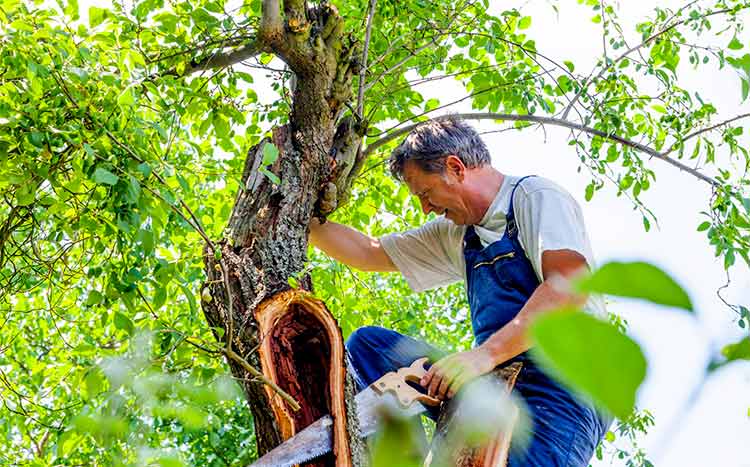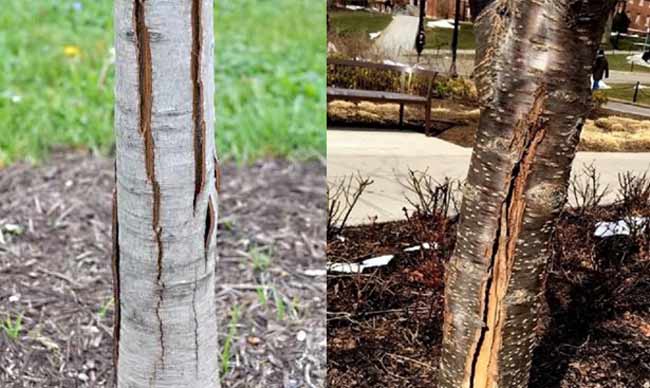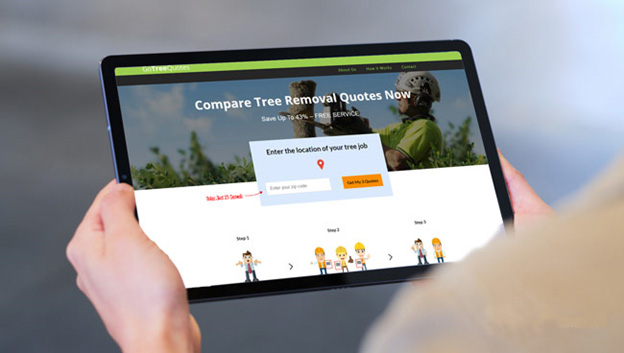Like any living thing, trees can get sick and die after some time. Many things can make a tree sick, such as insects, storms, and lack of enough nutrients. If left unchecked, the tree will eventually die, rot and fall.
While humans and animals can heal, trees cannot. Trees do not have the capability of replacing or repairing damaged tissues. Instead, they seal wounds1 by growing fresh tissue over the top. This prevents further damage from insects or diseases.
Once the tree starts decaying, you cannot reverse the process. However, proper tree care can limit decay and add several years to the trees.

How to repair a damaged trunk
A storm, fire, animals, and improper pruning may damage a tree trunk. The wounds cause to break the tree’s bark and interfere with water, food, and nutrient-conducting tissues. Also, the wounds expose the tree’s interior, making it susceptible to fungi and bacteria. To repair the tree trunk, you should:
Step 1 – Clean cuts
Cut off all ragged bark edges using a sharp knife but be cautious not to cut healthy bark and cause more harm to the tissue. Cutting off damaged bark will help clean the wound and make the bark smooth and tight against the trunk.
Step 2 – Monitor
Monitor the wound for a few days to determine whether there is any healing or compartmentalization.
Step 3 – Bolt if needed
If the damage is extensive, and the split in the trunk is affecting the structural integrity of the tree, bolting it back together might be a good option. The parts will eventually fuse as layer upon layer is added each year by the tree as it grows.

Should you seal a tree wound?
Sealing a tree wound does not prevent the disease or damage from spreading internally. It may even interfere with the natural wound closer to the tree. For this reason, it is better to let the tree heal on its own by compartmentalizing the wound with layers of cells to prevent the damage from spreading. Once the tree seals off the wounds, it will prevent decay organisms from entering, which will protect the tree from further damage.
What should I do if a tree has a split trunk?
In this case, the tree may be a hazard depending on the size, so you may need the help of a qualified arborist to assess the damage and advise as to whether the tree can be saved.
There are many ways to find a qualified arborist, but the fastest and easiest way is to use this FREE service.
The fastest and easiest way to get 3 Estimates from the most affordable tree services near you would be by using this FREE service.
GoTreeQuotes quickly matches you with the 3 local tree surgeons to get 3 Estimates from the most affordable tree services near you.
- Scroll up to the top of the page and enter your ZIP Code in the blue form at the top of the page.
- Give us a few details about your tree trimming or removal job, plus some contact information.
- Your tree details are forwarded to the closest three tree services, all voted best priced who will also price your tree job.






What do you put on a tree after cutting a branch?
After removing a tree branch, some people use prune sealers to minimize sap loss and prevent decay organisms from entering. These products are usually petroleum-based, and some may contain asphalt. Natural sealers are also available, and they contain collagen and aloe gel.
If the tree is actively growing, you may not need sealers because the tree will close the damaged tissue on its own within a few days.
Can a damaged tree be saved?
Saving a damaged tree will depend on the extent of the damage. If the limbs are strong and the tree is healthy, it is possible to save the tree. You may need to prune the broken branches and repair the torn bark and rough edges around the wound. Then, leave the tree to begin its wound repair process. If the damage is extensive, it may not be easy to salvage the tree, which may call for removal.
Does bark regenerate?
The bark of a tree is like human skin. It does not grow back once it comes off, and it exposes the inner layer of the tree’s live tissues. Usually, a tree seals the wound and creates a barrier to prevent the damage from extending. Sealing the wound also prevents decay2 agents from entering the tree.
What is tree repair tape?
A Tree tape is a commercial product used to wrap the tree to protect the bark from harsh weather like winter. It comes in a variety of materials, including paper, polypropylene, and burlap. Some people use this tape to protect tree wounds and prevent contaminants from entering.
FAQ’s
Can pruning a tree kill it?
Pruning a tree will not kill it if you do not remove some parts of the canopy. The tree will eventually regain from the loss and grow new leaves and branches. Over pruning, the tree may, however, cause severe damage to the tree. Although it will not directly kill the tree, over-pruned shrubs and trees tend to die due to associated stress after some time.
Can a tree that has fallen over be saved?
This depends on the size of the tree. If the fallen tree is large, saving it may not be possible, so it will have to be removed. However, a smaller tree can be straightened and saved. Power lifts and other lifting equipment will brace the tree and pull it upright. With the right care and maintenance, the tree will regain its stability and continue growing healthy.
What do you do if a branch breaks off?
All broken branches should be removed from the tree to minimize or prevent the risk of decay agents from entering the wound. Prune smaller branches at the attachment point with larger trees. Large broken branches should be cut back to the tree’s trunk or main limb by a tree professional.
- Lindsey Purcell, (2020) Tree Wounds and Healing. <https://www.purdue.edu/fnr/extension/tree-wounds-and-healing/> Accessed: 06-03-2024
- The Morton Arboretum, (2023) Trunk Wounds and Decay. <https://mortonarb.org/plant-and-protect/tree-plant-care/plant-care-resources/trunk-wounds-and-decay/> Accessed: 06-03-2024



